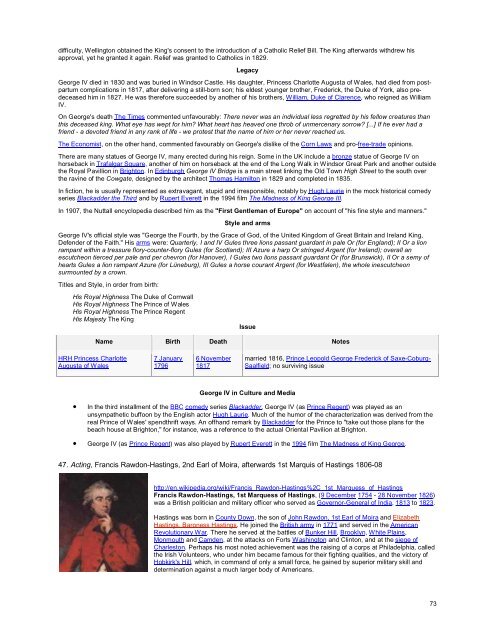Grand Masters of Scotland - Onondaga and Oswego Masonic ...
Grand Masters of Scotland - Onondaga and Oswego Masonic ...
Grand Masters of Scotland - Onondaga and Oswego Masonic ...
You also want an ePaper? Increase the reach of your titles
YUMPU automatically turns print PDFs into web optimized ePapers that Google loves.
difficulty, Wellington obtained the King's consent to the introduction <strong>of</strong> a Catholic Relief Bill. The King afterwards withdrew his<br />
approval, yet he granted it again. Relief was granted to Catholics in 1829.<br />
Legacy<br />
George IV died in 1830 <strong>and</strong> was buried in Windsor Castle. His daughter, Princess Charlotte Augusta <strong>of</strong> Wales, had died from postpartum<br />
complications in 1817, after delivering a still-born son; his eldest younger brother, Frederick, the Duke <strong>of</strong> York, also predeceased<br />
him in 1827. He was therefore succeeded by another <strong>of</strong> his brothers, William, Duke <strong>of</strong> Clarence, who reigned as William<br />
IV.<br />
On George's death The Times commented unfavourably: There never was an individual less regretted by his fellow creatures than<br />
this deceased king. What eye has wept for him? What heart has heaved one throb <strong>of</strong> unmercenary sorrow? [...] If he ever had a<br />
friend - a devoted friend in any rank <strong>of</strong> life - we protest that the name <strong>of</strong> him or her never reached us.<br />
The Economist, on the other h<strong>and</strong>, commented favourably on George's dislike <strong>of</strong> the Corn Laws <strong>and</strong> pro-free-trade opinions.<br />
There are many statues <strong>of</strong> George IV, many erected during his reign. Some in the UK include a bronze statue <strong>of</strong> George IV on<br />
horseback in Trafalgar Square, another <strong>of</strong> him on horseback at the end <strong>of</strong> the Long Walk in Windsor Great Park <strong>and</strong> another outside<br />
the Royal Pavillion in Brighton. In Edinburgh George IV Bridge is a main street linking the Old Town High Street to the south over<br />
the ravine <strong>of</strong> the Cowgate, designed by the architect Thomas Hamilton in 1829 <strong>and</strong> completed in 1835.<br />
In fiction, he is usually represented as extravagant, stupid <strong>and</strong> irresponsible, notably by Hugh Laurie in the mock historical comedy<br />
series Blackadder the Third <strong>and</strong> by Rupert Everett in the 1994 film The Madness <strong>of</strong> King George III.<br />
In 1907, the Nuttall encyclopedia described him as the "First Gentleman <strong>of</strong> Europe" on account <strong>of</strong> "his fine style <strong>and</strong> manners."<br />
Style <strong>and</strong> arms<br />
George IV's <strong>of</strong>ficial style was "George the Fourth, by the Grace <strong>of</strong> God, <strong>of</strong> the United Kingdom <strong>of</strong> Great Britain <strong>and</strong> Irel<strong>and</strong> King,<br />
Defender <strong>of</strong> the Faith." His arms were: Quarterly, I <strong>and</strong> IV Gules three lions passant guardant in pale Or (for Engl<strong>and</strong>); II Or a lion<br />
rampant within a tressure flory-counter-flory Gules (for <strong>Scotl<strong>and</strong></strong>); III Azure a harp Or stringed Argent (for Irel<strong>and</strong>); overall an<br />
escutcheon tierced per pale <strong>and</strong> per chevron (for Hanover), I Gules two lions passant guardant Or (for Brunswick), II Or a semy <strong>of</strong><br />
hearts Gules a lion rampant Azure (for Lüneburg), III Gules a horse courant Argent (for Westfalen), the whole inescutcheon<br />
surmounted by a crown.<br />
Titles <strong>and</strong> Style, in order from birth:<br />
His Royal Highness The Duke <strong>of</strong> Cornwall<br />
His Royal Highness The Prince <strong>of</strong> Wales<br />
His Royal Highness The Prince Regent<br />
His Majesty The King<br />
Issue<br />
Name Birth Death Notes<br />
HRH Princess Charlotte<br />
Augusta <strong>of</strong> Wales<br />
7 January<br />
1796<br />
6 November<br />
1817<br />
married 1816, Prince Leopold George Frederick <strong>of</strong> Saxe-Coburg-<br />
Saalfield; no surviving issue<br />
George IV in Culture <strong>and</strong> Media<br />
• In the third installment <strong>of</strong> the BBC comedy series Blackadder, George IV (as Prince Regent) was played as an<br />
unsympathetic buffoon by the English actor Hugh Laurie. Much <strong>of</strong> the humor <strong>of</strong> the characterization was derived from the<br />
real Prince <strong>of</strong> Wales' spendthrift ways. An <strong>of</strong>fh<strong>and</strong> remark by Blackadder for the Prince to "take out those plans for the<br />
beach house at Brighton," for instance, was a reference to the actual Oriental Pavilion at Brighton.<br />
• George IV (as Prince Regent) was also played by Rupert Everett in the 1994 film The Madness <strong>of</strong> King George.<br />
47. Acting, Francis Rawdon-Hastings, 2nd Earl <strong>of</strong> Moira, afterwards 1st Marquis <strong>of</strong> Hastings 1806-08<br />
http://en.wikipedia.org/wiki/Francis_Rawdon-Hastings%2C_1st_Marquess_<strong>of</strong>_Hastings<br />
Francis Rawdon-Hastings, 1st Marquess <strong>of</strong> Hastings, (9 December 1754 - 28 November 1826)<br />
was a British politician <strong>and</strong> military <strong>of</strong>ficer who served as Governor-General <strong>of</strong> India, 1813 to 1823.<br />
Hastings was born in County Down, the son <strong>of</strong> John Rawdon, 1st Earl <strong>of</strong> Moira <strong>and</strong> Elizabeth<br />
Hastings, Baroness Hastings. He joined the British army in 1771 <strong>and</strong> served in the American<br />
Revolutionary War. There he served at the battles <strong>of</strong> Bunker Hill, Brooklyn, White Plains,<br />
Monmouth <strong>and</strong> Camden, at the attacks on Forts Washington <strong>and</strong> Clinton, <strong>and</strong> at the siege <strong>of</strong><br />
Charleston. Perhaps his most noted achievement was the raising <strong>of</strong> a corps at Philadelphia, called<br />
the Irish Volunteers, who under him became famous for their fighting qualities, <strong>and</strong> the victory <strong>of</strong><br />
Hobkirk's Hill, which, in comm<strong>and</strong> <strong>of</strong> only a small force, he gained by superior military skill <strong>and</strong><br />
determination against a much larger body <strong>of</strong> Americans.<br />
73







![Richard [Nicholls] Harison / Harrison - Onondaga and Oswego ...](https://img.yumpu.com/24950065/1/190x245/richard-nicholls-harison-harrison-onondaga-and-oswego-.jpg?quality=85)

![Richard [Nicholls] Harison / Harrison - Onondaga and Oswego ...](https://img.yumpu.com/24950063/1/190x245/richard-nicholls-harison-harrison-onondaga-and-oswego-.jpg?quality=85)







